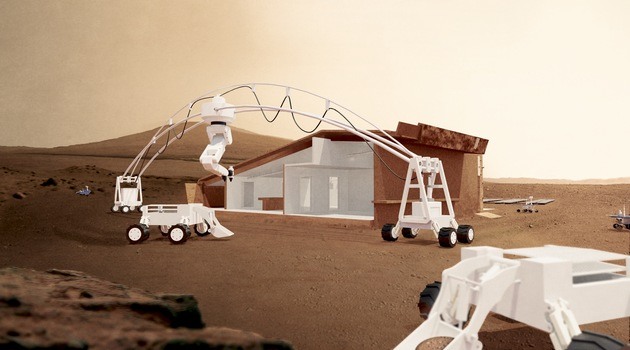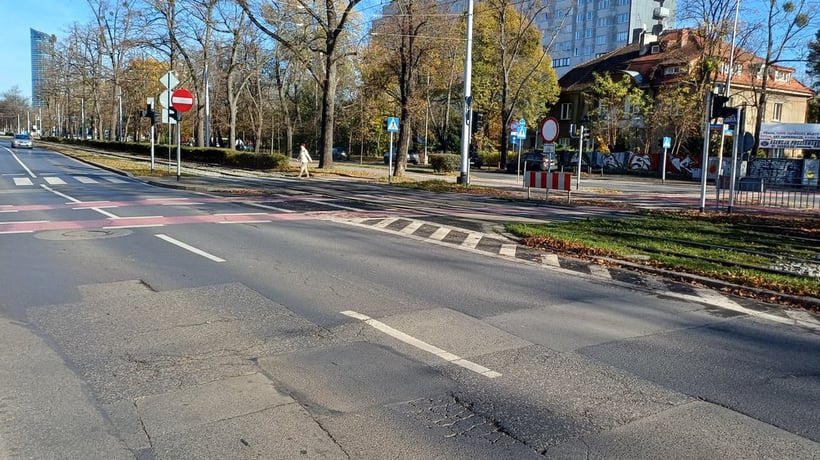Have you seen "The Martian" by Ridley Scott yet?
Leszek Orzechowski: Of course we have. This is part of our job, really. We also read "The Martian" long before that. We wanted to find out how the book was translated into the language of the cinema. The final result is not bad, and it's difficult to find fault in it. By the way, even people from NASA say the film is just perfect to promote space exploration. It's both gripping and scientifically accurate. Haven't you been trying to spot things that are improbable for scientists?
Szymon Gryś: We heard that the film was fine even before the screening. That the script differed only slightly from the book, and the book was really close to reality. Leszek: There is one exception, though, which is probably to make the film more attractive to the audience. The main hero is confined to the Red Planet when a massive storm sets in and the entire crew is made to flee. Hit with an aerial, the hero is considered dead and is left to his own devices. In fact, no such storm happened in the book. But it's difficult to pick on this detail; it's better to focus on the rest, which is accurate and well executed. How would you explain today's interest in Mars? Films, research reports and space exploration plans are just a handful of information on the Red Planet that has been circulated over the last few years.
Szymon: The American programme for space exploration using space shuttles folded at the beginning of the decade, and the global space industry fell into a slump as a result. All of a sudden it turned out that only Russian rockets were used to send people into space. Roving vehicles were landed on Mars, which attracted interest from space enthusiasts. Only when the plans to send people into space were revealed by Boeing, SpaceX and other companies did the interest in space exploration return. Films such as "Gravity" or "Interstellar" soon followed suit. Leszek: Space is now like a new Neverland. Previously, "Harry Potter" and "The Lord of the Rings" would serve as Neverlands. Now it's the space that does it. This is the only Neverland which we can actually hope to explore. It exists, in reality and not in imagination. It's only a matter of time when we make it. People in NASA have been hesitating to present a consistent plan for future space exploration after the space shuttle stage, which ate up massive amounts of money and failed to meet the expectations. Only two or three weeks ago did NASA present a detailed plan of how to fly to Mars. The Americans are launching marketing machinery to sell the following idea: we will be flying to Mars in 15 to 20 years. You must be ready for this. We are creating new technologies to make it possible.
 Photograph: Space Is More
Photograph: Space Is More
Are you sure we will live to see the day when first people land on Mars?
Leszek: Yes, I am. You can trust NASA and their goals. They also have competitors. We are now witnessing a new space race, among private institutions and not the countries, though. Several companies are planning to send people to space stations; several others are going to extract precious ore from asteroids. To put it simply, the world's wealthiest are investing millions or billions of dollars into the space industry. Szymon: The European Space Agency is also planning to launch space exploration projects; in 10 years' time they want to return to the Moon, which is a milestone towards further exploration. They are planning to set up space station on the dark side of the Moon, which is very interesting. Leszek: The European Space Agency is now running a competition for the design on the entire mission to the Moon in 2020-2030, and we are also taking part in it. The contestants are preparing a plan necessary to return to the Moon and build a permanent station on the planet.
We have a strong international team to do this.
That's another competition that Space Is More has joined this year. You have just returned from New York, where you attended the final of the NASA competition in which you made to the final ten and were awarded a distinction.
People in NASA are playing an open game: we are flying to Mars in 15 to 20 years' time and we have to consider how to organise such a mission. Mars is known for its low pressure, which in turn translates into low temperatures. There is also little air in the atmosphere, which makes it very difficult to decelerate. That's why we cannot send anything big to Mars, anything heavier than a tonne is simply impossible. This is quite likely to change when new technologies develop, but for the time being we're unable to construct a large building on Mars. That's why NASA is now running a competition to show how to print a complete habitat in 3D using soil or rocks available on Mars. So instead of the entire building we're only taking 3D printers to create it. Then we can create as many habitats as we like. That's the main idea. The jury evaluated the design's feasibility, what main challenges it might be facing and if the proposed technology is not too fancy to be applicable on Earth. This down-to-earth quality was rated higher than its future applications on Mars. The idea from NASA is this: we're flying to Mars in 20 years' time and we are aware that technology is going to develop, but by that time we will have applied For example, to develop affordable housing estates using 3D printers. Eventually, we've made it to the final ten.

fPhotograph: Space Is More
What have the jury awarded in your design?
Simplicity and feasibility.
Even though the competition was organised to award the best 3D printing technology to be used on Mars, we have won recognition by offering a technology that is easier to use on Earth. We may develop a prototype in one year and start constructing buildings here on Earth.
And what have the winners shown?
They won because they presented the most innovative idea to print from frozen water. They created a frozen palace, a habitat made entirely of ice. You can't do this on Earth unless it's in Antarctica. Their approach was the most innovative to be submitted in the programme, although at the back of their mind they knew it's simply impossible on Earth. But they staked everything on one card. That's why they won with competitors such as Foster and Partners or the European Space Agency crew. We were ranked just behind these guys, who are all great company to compete with. You can now safely say that we are in the elite when it comes to space architecture.
How important are these competitions for NASA? Are the Americans looking for people who offer potential, innovation and ambition and whose ideas may serve as a stepping stone towards technologies to be used in 10 or 15 years for Mars exploration?
Szymon: Even though we haven't won, it's quite likely that is few years’ time someone will call with a proposal for collaboration. We have to be ready to take on the challenge in the future. Leszek: As we attend these events, we speak with a variety of people and discuss our ideas. We network a lot and exchange lots of business cards. It is true that NASA will be benefiting from our ideas. But they are also expecting that we will develop our ideas further. The New York stage of the competition served to present technology and architecture. NASA would like us to find investors, create a prototype and printed here on Earth. That's what is going to help us the subsequent stage in the competition in which you can gain as much as two million USD. We get a ready product and technology while people from NASA obtain a tested solution. Szymon: You have to bear in mind that space business is completely different than any other type of industry. The automotive industry is so powerful that they can choose people they want to work with. Our environment is much smaller and it takes a lot of time and work to get the necessary know-how. However, once you've learnt everything, it's much easier for you to pursue new projects.
There are only a handful of people working for the space industry in Poland, so international cooperation seems to be necessary.
Szymon: This goes without saying, Poland will never have its own space fleet. What we can do is to understand how the space industry works and specialise in one particular field. That's what scientists from the Polish Academy of Sciences are doing as they produce penetrators used for space exploration. They have carved their own niche and are now making the best penetrators in the world. The second branch is theory and conceptual design. This includes competitions such as the one by NASA. If you present a good design, there's a chance for you to collaborate with space agencies in the future The competition we are now taking part in involves working with people from the United States, Japan, Italy and Great Britain. One of the conditions to join it was to have people from at least two continents in the crew. Leszek: Poland pays 40 million EUR for the membership in the European Space Agency. The money should return to Poland with new designs, funding for new initiatives and space sector development. We have made the most of this money. Sadly, it mostly benefits foreign companies which are only residing in Poland. The investment in the space industry is not a fad that only the wealthiest and most developed can afford. It pays. And it can benefit our daily life. After all, we use GPS, mobile phones, non-stick pans and even Velcro shoes. All these solutions were first tested by space explorers.

Photograph: Space Is More
When did you realise that you are no longer students or enthusiasts but fully-fledged professionals?
Szymon: Each of us was passionate about space and space exploration even before we met. When we took to our first project called "Inspiration Mars", we already knew it was for real. Leszek: As we made it to the final of the "Inspiration Mars" competition, we had to find money for the trip and to show our business acumen. And when we made contact with NASA, we saw research centres, and we were so spellbound that we decided we want to do this and be part of this world. That was a big boost. We're not going to slow down in the nearest future.
Would you say that Space Is More is a place to prepare people and help them find jobs in a large space agency?
Szymon: Of course it sounds good if you say you're working for NASA, but we would prefer to work on our own in collaboration with the space agency. Then we can pursue what we've been doing so far, and we don't have to give up on our own legacy. We're not treating our team as an opportunity to make careers and land better jobs. We intend to develop Space Is More as a brand of our own. Leszek: We have our own brand and it's much easier now to find money for developing new projects. We are endorsed by the Wroclaw University of Technology and the Wroclaw City Office. We are networking with serious companies that are happy with our collaboration. In due course we will also be working with space agencies.






